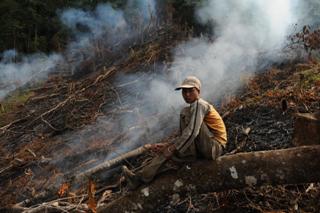Jul 9 2015
Increasing amounts of environmentally valuable and protected land are being cleared for rubber plantations that are economically unsustainable, new research suggests. More widespread monitoring is vital to design policy that protects livelihoods and environments.
 On marginal lands there is a high risk of rubber plantation failure, which exposes these farmers to economic risks. (credit: Jianchu Xu, World Agroforestry Centre)
On marginal lands there is a high risk of rubber plantation failure, which exposes these farmers to economic risks. (credit: Jianchu Xu, World Agroforestry Centre)
The research was recently published in Global Environmental Change and constitutes a joint effort by scientists at the World Agroforestry Centre (ICRAF) East and Central Asia office, the Chinese Academy of Sciences, the Royal Botanic Garden Edinburgh, the University of Singapore and the East-West Center.
Although global natural rubber prices have fluctuated strongly in the last fifteen years, they are likely to continue rising as synthetic alternatives are no match for natural latex. This financial incentive, as well as the expansion of oil palm, an even more lucrative rival, has caused rubber plantations to expand beyond their tropical comfort zone in Indonesia and into the margins of continental south-east Asia.
This has brought wealth to some, but not all, say the researchers. As marginal lands are often too dry, too slanted, too high, too wet, too cold, too windy, or a combination of the above, rubber plantations require increasing amounts of input in the form of fertilizer, pesticides, and labour in order to maintain yield levels - and even then may not be profitable.
The research also suggests that climate change will render 70% of current and another 55% of future plantation areas environmentally poorly suited for rubber. Smallholder farmers' livelihoods face additional threat from price fluctuations, loss of food security, and the narrowing of income sources.
The environment also suffers. The surge in rubber demand saw valuable and even protected lands being converted into rubber plantations, drastically reducing carbon stocks, soil productivity, water availability, and biodiversity. This is particularly tragic given the high chance of failure.
"There is clear potential for loss-loss scenarios when forest is being cleared for rubber plantations that are not economically sustainable, and that have negative impacts on soils and water balance," says lead researcher Antje Ahrends from the Royal Botanic Garden Edinburgh and the World Agroforestry Centre.
Widespread monitoring of rubber expansion and its economic sustainability will prove vital for land-use planning and policy interventions. The team argue that carefully formulated payment for ecosystem services programmes, and a certification scheme for "environmentally friendly rubber" have potential to reduce the environmental impact of rubber expansion while ensuring the supply.
"Oil palm has received much more global attention than rubber, but in fact environmental and social impacts are comparable and the dynamics of the two are related. It may be time for a roundtable on sustainable rubber where the private sector, public parties and scientists can try to bridge the various interests and agree on standards," says Meine Van Noordwijk, chief science advisor at the World Agroforestry Centre.